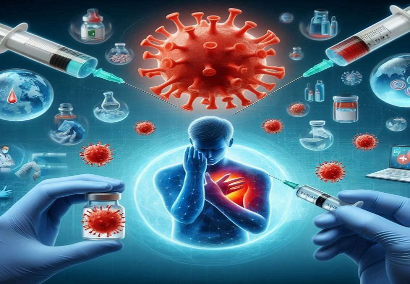News Release | April 16, 2024
WASHINGTON — A new report from the National Academies of Sciences, Engineering, and Medicine reviews evidence for 19 potential harms of the COVID-19 vaccines, and for nine potential shoulder injuries from intramuscular administration of vaccines more broadly. The committee that conducted the review identified sufficient evidence to draw 20 conclusions about whether these vaccines could cause specific harms, and drew 65 conclusions where it did not find enough evidence to establish, accept, or reject a causal relationship.
The Health Resources and Services Administration requested that the National Academies convene a committee to review the evidence regarding specific potential harms related to the COVID-19 vaccines used in the United States, for which HRSA had received claims for compensation under its Countermeasures Injury Compensation Program (CICP).
As part of “Operation Warp Speed,” a rapid response by the federal government to speed vaccine development during the COVID-19 pandemic, four vaccines were developed and authorized for emergency use in the U.S., with some now fully approved by the Food and Drug Administration. COVID-19 vaccines are estimated to have prevented 14.4 million deaths worldwide in the first year they were available.
COVID-19 Vaccines and Possible Harms
The report concludes that two messenger ribonucleic acid (mRNA) vaccines, manufactured by Pfizer-BioNTech and Moderna, can cause myocarditis — inflammation of the heart muscle. Evidence suggests the two mRNA vaccines do not cause infertility, Guillain-Barré syndrome, Bell’s palsy, thrombosis with thrombocytopenia syndrome (TTS), or myocardial infarction (heart attack). Evidence also suggests the Pfizer-BioNTech vaccine does not cause ischemic stroke.
Although there are a limited number of published studies on the Janssen vaccine, reflecting its limited use in the U.S., evidence suggests this vaccine may cause TTS and Guillain-Barré syndrome.
The report says that for all conclusions that do not establish a causal link, future studies that estimate effects more precisely or that better minimize bias and confounding variables could lead to a different finding.
“Despite a large body of evidence from extraordinary efforts by investigators around the world, our committee found that in many cases, if not most, evidence was insufficient to accept or reject causality for a particular potential harm from a specific COVID-19 vaccine,” said committee vice chair Anne Bass, professor of clinical medicine, Weill Cornell Medicine, and a rheumatologist at the Hospital for Special Surgery and New York Presbyterian Hospital. “In other cases, we did find sufficient evidence to favor rejection, favor acceptance, or establish causality. It is important to note, however, that identifying a harm does not mean that it occurs frequently. Harms associated with vaccines are rare.”
Shoulder Injuries and Possible Harms
HRSA also requested that the committee review the evidence regarding any vaccine administration — not specifically COVID-19 vaccines — and shoulder injuries, to help its National Vaccine Injury Compensation Program (VICP) better understand whether vaccination can cause very specific types of shoulder injuries or a more general syndrome that it designated as “Shoulder Injuries Related to Vaccine Administration.” The report says that evidence shows vaccination may cause four specific shoulder injuries: acute subacromial/subdeltoid bursitis caused by direct injection of a vaccine into the bursa; acute rotator cuff tendinopathy caused by direct injection into or adjacent to a tendon; bone injury caused by direct injection into or adjacent to bone; and axial or radial nerve injury due to direct injection into or adjacent to the nerve. In addition, evidence suggests that intramuscular vaccine administration does not cause chronic rotator cuff disease.
Evidence in Children
Because potential vaccine-associated harms may differ in children and adults, the committee conducted an in-depth review of literature on adverse events related to COVID-19 vaccines in children under 18, and found insufficient evidence to make conclusions specific to children. At the time of the committee’s review, data on children were only available for the Pfizer-BioNTech and Moderna vaccines, due to later authorization of COVID-19 vaccines for emergency use in children, and decreased uptake of COVID-19 vaccines in children, particularly those younger than 11. Ongoing and future pharmacovigilance and epidemiology studies should produce more definitive data on the risk and relative incidence of harms of COVID-19 vaccines in children.
About This Study
The report says all conclusions must be assessed in the context of the established harms of COVID-19 infection and the well-documented benefits of COVID-19 vaccines in preventing infection. The committee was not tasked with estimating the magnitude or strength of associations between vaccinations and outcomes, and did not offer conclusions regarding specific patient cases or whether VICP or CICP should award compensation in individual cases or in general.
“Given that the studies we reviewed were performed shortly after vaccines were available, the information in this report is a snapshot in time, and new vaccines will be developed and more research conducted,” said George Isham, senior fellow, HealthPartners Institute, and chair of the committee that wrote the report. “For example, the evidence does not address the real-world use of the COVID-19 vaccines in which many individuals received a ‘mix and match’ sequence of them. Many people vaccinated for COVID-19 also received other vaccines, such as influenza, simultaneously.”
The study — undertaken by the Committee to Review Relevant Literature Regarding Adverse Effects Associated with Vaccines — was sponsored by the Health Resources and Services Administration of the U.S. Department of Health and Human Services.
The National Academies of Sciences, Engineering, and Medicine are private, nonprofit institutions that provide independent, objective analysis and advice to the nation to solve complex problems and inform public policy decisions related to science, engineering, and medicine. They operate under an 1863 congressional charter to the National Academy of Sciences, signed by President Lincoln.
